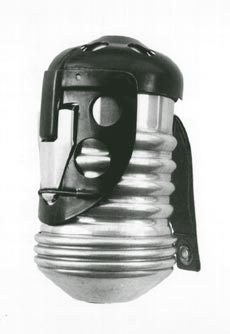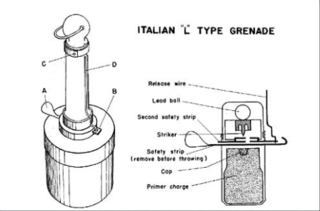History
The Royal Italian Army had entered World War II war without an anti-tank grenade of domestic production. Only in 1942 were two models built: the OTO Mod. 42 and the Breda Mod. 42. This was achieved by modifying the Breda Mod. 40. In June 1942, the Breda Brescia produced 10.000 copies to be submitted to the high rank of the military, but the explosive device, due to numerous missing activations, did not pass the test carried out in April 1943. [1]
With the creation of specific "tanks-hunters" units, which took place precisely in 1942, two types of anti-tank grenades were adopted, an explosive and an incendiary one. The first, the Breda mod. 42, employed mechanical parts of the normal Breda mod. 35. The second, the O.T.O. mod. 42, it was an improved version of the incendiary bottle with 600 grams of flamethrowers liquid, it was triggered by a normal hand grenade O.T.O. mod. 35 with slight modifications. The safety systems of the two bombs did not differ from those used on normal bombs and anti-personnel Breda O.T.O hand. [2]

A Molotov cocktail is a hand-thrown incendiary weapon consisting of a frangible container filled with flammable substances and equipped with a fuse. In use, the fuse attached to the container is lit and the weapon is thrown, shattering on impact. This ignites the flammable substances contained in the bottle and spreads flames as the fuel burns.

A shell, in a military context, is a projectile whose payload contains an explosive, incendiary, or other chemical filling. Originally it was called a bombshell, but "shell" has come to be unambiguous in a military context. A shell can hold a tracer.
A rifle grenade is a grenade that uses a rifle-based launcher to permit a longer effective range than would be possible if the grenade were thrown by hand.
OTO Melara was a subsidiary of the Italian company Finmeccanica, today Leonardo, active in the defence sector, with factories in Brescia and La Spezia. The Mod 56 pack howitzer, in service throughout the world, and the 76mm naval gun, adopted by 53 navies and installed on over 1,000 naval vessels, are among OTO Melara's best known weapons since World War II.

The No. 73 grenade, also known as the "Thermos", "Woolworth bomb", or "hand percussion grenade", was a British anti-tank grenade used during the Second World War. It got its nickname from the resemblance to a Thermos flask.
The military of the United States has used many different types of hand grenades since its foundation.

The Ansaldo 105/25 M43, also known as Semovente 105/25, was an Italian self-propelled gun used during World War II and designed by Ansaldo. It was the most powerful self-propelled gun built by Italy in numbers during World War II.
Breda-SAFAT was an Italian weapons manufacturer of the 1930s and 1940s that designed and produced a range of machine-guns and cannon primarily for use in aircraft. Based on the M1919 Browning machine gun, the Italian guns were chambered to fire indigenous ammunition with 7.7 mm (0.303 in) and 12.7 mm (0.500 in) calibres, predominantly ball, tracer for the 7.7mm, including high explosive incendiary tracer (HEI-T), or armour-piercing (AP) for the 12.7mm.

A grenade is an explosive weapon typically thrown by hand, but can also refer to a shell shot from the muzzle of a rifle or a grenade launcher. A modern hand grenade generally consists of an explosive charge ("filler"), a detonator mechanism, an internal striker to trigger the detonator, an arming safety secured by a transport safety. The user removes the transport safety before throwing, and once the grenade leaves the hand the arming safety gets released, allowing the striker to trigger a primer that ignites a fuze, which burns down to the detonator and explodes the main charge.

Poudreries Réunies de Belgique SA was one of Belgium's oldest and largest manufacturers of munitions, once the second-largest Belgium armaments manufacturer. The company indirectly started in 1778 in Wetteren as a gunpowder factory. By its 200th anniversary in 1979 it had 73 factories throughout the world, with the headquarters in Brussels.

The Breda Mod. 35 is a hand grenade issued to the Royal Italian Army during World War II.

The OTO Mod. 35 was a hand grenade issued to the Regio Esercito during World War II.

The SRCM Mod. 35 is a hand grenade that was first issued to the Royal Italian Army in 1935, serving through World War II and into the 1980s. Nicknamed "Red Devils" by the British in 1941–1942 during the North African Campaign after the red color of the most common type.

The Type L is an anti-tank hand grenade provided to the Royal Italian Army during World War II.

The OTO Mod. 42 is an incendiary anti-tank hand grenade supplied to the Royal Italian Army during World War II.

The Type 3 "anti-tank" hand grenade is a Japanese grenade produced from 1943 to 1945 during World War II. It was designed to destroy the Allies' tanks. There are three variants (sub-types) of the weapon: Ko, Otsu, and Hei.

Passaglia Grenades, also known as P Bombs or Pazzaglia, are homemade weapons used by Italian soldiers during World War II, especially in the North African theater to overcome the chronic lack of effective weapons against armored enemies.
This page is based on this
Wikipedia article Text is available under the
CC BY-SA 4.0 license; additional terms may apply.
Images, videos and audio are available under their respective licenses.













